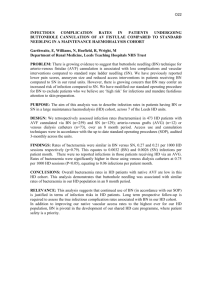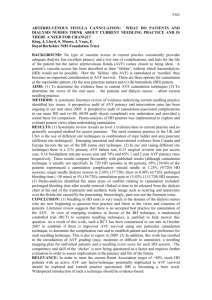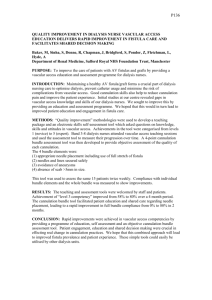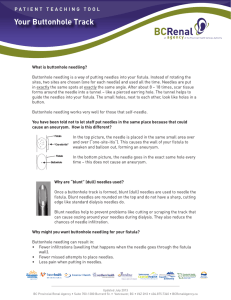On Course With Cannulation
advertisement
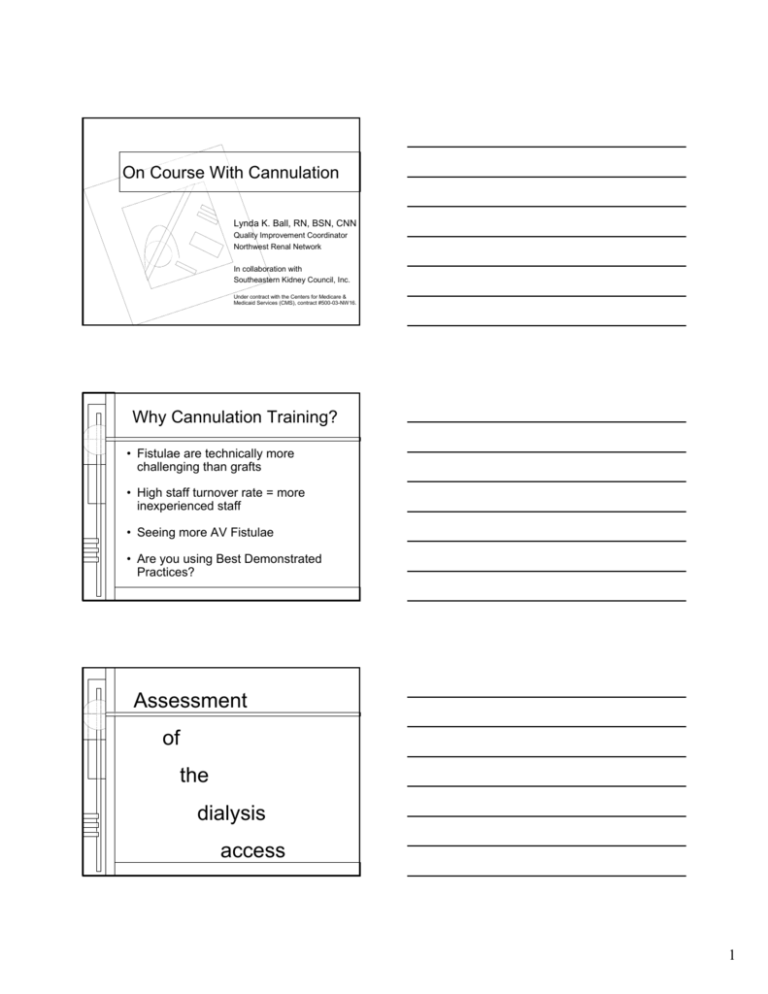
On Course With Cannulation Lynda K. Ball, RN, BSN, CNN Quality Improvement Coordinator Northwest Renal Network In collaboration with Southeastern Kidney Council, Inc. Under contract with the Centers for Medicare & Medicaid Services (CMS), contract #500-03-NW16. Why Cannulation Training? • Fistulae are technically more challenging than grafts • High staff turnover rate = more inexperienced staff • Seeing more AV Fistulae • Are you using Best Demonstrated Practices? Assessment of the dialysis access 1 Inspection • Redness • Drainage • Abscess • Skin color • Edema • Small blue or purple veins Infection • Hands: Cold Painful Numb • Fingers: discolored Steal Syndrome Central or outflow • Prior cannulation sites vein stenosis Palpation Temperature 9 Warmth = infection 9 Cold = decreased blood supply Thrill 9 Normally a thrill is present at the anastamosis, and disappears when you manually occlude the AVF. 9 If a thrill remains = accessory veins 9 Thrill can be felt at the site of a stenosis Palpation Vein Diameter 9 Feel the entire length of the AVF 9 Evaluate for needle site selection 9 Check for flat spots – you can see a stenosis and feel its thrill 9 Evaluate if new AVF is ready to cannulate 2 Auscultation Bruit 9 Listen every treatment 9 Changes in characteristics: discontinuous high-pitched 9 Determine direction of flow Types of Stenoses • Juxta-anastomotic (inflow) Central vein • Outflow Outflow • Central vein Inflow Causes of Stenosis • Turbulence • Aneurysm and pseudoaneurysm formation • Needle stick injury to vessel wall 3 Aneurysm • Caused by sticking needles in the same general area. • Cause stenosis formation because of turbulence Photo courtesy of P. Cade Checking for Stenosis • Squeeze the kidney with your arm hanging down by your side and observe vein filling. • Raise arm overhead and observe vein for collapse. Physical Findings of Venous Stenosis PARAMETER NORMAL STENOSIS Thrill Only at the arterial anastamosis At site of stenotic lesion Pulse Soft, easily compressible Water-hammer Bruit Low pitch Continuous Diastolic & systolic High pitch Discontinuous Systolic only G.A. Beathard, MD, PhD 4 Clinical Indicators of Stenosis • • • • • • • Clotting the system 2 or more times/month Difficult needle placement Persistently swollen arm Difficulty achieving hemostasis post dialysis venous pressure blood pump speeds, KT/V and URR Recirculation Steal Syndrome What is Steal Syndrome? • Decreased blood supply to the hand • Causes hypoxia (lack of oxygen) to the tissues of the hand resulting in severe pain • Without oxygen, tissue dies and necrosis occurs • Grafts and upper arm fistulas cause the most steal 5 Steal - High Risk Individuals • Steal Syndrome resolves itself in 95% of the cases due to the development of collateral circulation • Those 5% who need intervention are: ~Diabetics with neuropathy ~Patients with peripheral vascular disease • Neurologic damage to the hand can occur The Allen Test (negative) Preparation for Cannulation 6 Skin Preparation • The patient should wash their access with soap and water or alcohol-based product before coming to their chair. • Staph is the leading cause of infection in dialysis patients (CDC). Proper cleansing technique • Proper needle site preparation reduces infection rates. • Start where you are going to place the needle (the black dot) and cleanse in a circular, outward motion. Says Who? K/DOQI SAYS •Guideline 14: Skin Preparation Technique for Permanent AV Accesses • A clean technique for needle cannulation should be used for all cannulation procedures (Evidence). 1. Locate and palpate the needle cannulation sites prior to skin preparation. 2. Wash access site using an antibacterial soap or scrub (e.g., 2% chlorhexidine) and water. 3. Cleanse the skin by applying 70% alcohol and/or 10% povidone iodine using a circular rubbing motion. Notes: Alcohol has a short bacteriostatic action time and should be applied in a rubbing motion for 1 minute immediately prior to needle cannulation. Povidone iodine needs to be applied for 2-3 minutes for its full bacteriostatic action to take effect and must be allowed to dry prior to needle cannulation. Clean gloves should be worn by the dialysis staff for cannulation. Gloves should be changed if contaminated at any time during the cannulation procedure. New, clean gloves should be worn by the dialysis staff for each patient. 7 A Word About Anesthetics • Lidocaine causes • scarring, keloid formation and vasoconstriction. • Ethyl chloride – spray arterial site, prep, then insert needle. Repeat for venous site. NOT sterile. EMLA cream applied by the patient to the access, then they wrap with saran wrap. Works by time of contact, not by amount applied. Too much may cause vasodilation approx. 3 hours after application. Three-Point Technique • Stabilize vessel for both grafts and fistulas. • Guide to ensure needle is in the center of the access. • Pull the skin taut to allow easier needle insertion. • Compresses the nerve endings, blocking pain sensation to the brain for approximately 20 seconds. Problems associated with dialysis 8 Hemolysis - Arterial Pressure • The blood is removed from the patient by a negative pulling pressure. • Arterial pressures > -260 mmHg cause hemolysis. Reduce blood pump speed until pressure falls below this threshold. Notify MD that flow is not attainable. • The patient may need larger bore needles for their treatment. “One-site-itis” • “One-site-itis” occurs when you stick the needle in the same area, day after day. Vascular Access Area puncture technique aka “one-site-itis” • Causes aneurysm and stenosis formation. Clamps - Holding Sites • Clamps should not be used – no way to adjust pressure properly. • Compression of the vessel along with hypotension can cause the access to clot off. • Patients and/or family need to be taught to hold sites, otherwise, staff should hold. 9 Bruising - Holding Sites • If bruising occurs, the surface site has clotted, but the needle hole in the vessel wall has not. • Need to hold sites longer. • Use two fingers per site. Flipping Needles • Historically, we flipped all needles because we did not have backeye needles. • Causes enlargement of the entrance hole which allows blood to seep out around the needle during dialysis. • Can cause coring of the access, requiring surgical closure of the hole. • If cannulation technique is correct, rarely is there a need to flip needles. Different Cannulation Techniques 10 The Buttonhole Technique Another technique for inserting needles into native AV fistulae Facts About Buttonhole • Used in Europe and Japan for over 25 years. • First used on a patient with a limited area for cannulation. • For native AV Fistulas only. • Once called the “Constant-Site” method. • Dr. Kronung renamed it the “Buttonhole Puncture Technique.” Facts About Buttonhole (cont) • A comparison between “Rope Ladder” and “Constant-Site” techniques was done over 10,000 dialyses. • “Constant-Site” Technique had: * Fewer infections * Fewer infiltrations * Insertion easier - usually in less than 10 seconds * Fewer missed sticks * Fewer complications *10-fold in hematomas * Less pain – can eliminate anesthetic Twardowski 1979 11 Buttonhole Technique • Sticking the same site using the same angle and depth every time. Vascular Access Constant site technique aka Buttonhole technique • This technique has not been shown to cause aneurysm formation. Buttonhole • Requires the same “sticker” until the track is formed (~8 sticks, ~12 for diabetics) • Determine the best two sites on the access = good arterial and venous pressures, good blood pump speeds, and least likely areas for infiltrates Buttonhole • Scab removal the most important step to prevent infection • The Buttonhole Technique requires removing the scab before cannulating. • Moistening the scabs makes them easier to remove. • The scab will look like a mushroom, with a cap and stem. 12 Removing the Scab • Changing to blunt needles once the track is formed helps to prevent cutting of the scar track/tunnel. • Oozing will occur if the track/tunnel is cut after heparinizing the patient. Do’s and Don’ts of Scab Removal • Don’t flip the scab off with the needle you will use for cannulation – this contaminates the needle. • Don’t use a sterile needle – you could cut the patient’s skin and you will need a sharps container nearby. • Don’t let patients pick off scabs. • Do use either: ~aseptic tweezers; ~soak two 2 x 2s with sterile saline and lay over the scabs; ~moisten 2 x 2s with alcohol-based gel; or ~have patient tape alcohol squares over sites prior to dialysis. Needles – sharp and blunt 13 Changing to blunt needles • This will be individual to each patient, but you want to look for these things: ¾ Can you visualize a round hole? ¾ Does it look well-healed? ¾ Has the sharp needle been going in smoothly? • Do not use excessive force when changing to blunt needles. • You may need to rotate the needle back and forth while advancing down the track. A Developing Buttonhole A ridge is starting to develop. A hole is starting to develop. This site is not yet ready for a blunt needle. Developed Buttonhole Sites 14 Barriers to success • Heavily scarred accesses from: ¾ multiple problematic needle sticks ¾ long-lived AV fistulae ¾ lidocaine use ¾ keloid formation • Large amount of subcutaneous tissue • Not dedicating one staff person for cannulation during the track formation Cannulating a New AV Fistula When is an AVF Mature? • Nurse should look, listen and feel the new AVF every dialysis treatment and document • Start access exercises 1 week post-op • Soft/pliable firm/springy resistance • Diameter of vessel increasing (2mm 4-6 mm) • Experienced dialysis nurses have an 80% success rate identifying AVF maturity (Robbin et al, 2002) • Post-op visit at 4 weeks – if there is no progress there needs to be follow-up then (Beathard, 2003) 15 Cannulating a New AVF • Must have a physician’s order to cannulate. • Must have an experienced, qualified staff person who is successful with all types of accesses – rating system. • Always use a tourniquet or some form of vessel engorgement technique (e.g., staff or patient compressing the vein). Cannulating a New AVF (cont) • Check to see if heparin dose has been changed (decrease by half to prevent excess bleeding - opinion). • Use 17-gauge needles initially. • If patient has a catheter, use one limb and one needle. 1 Needle - Arterial or Venous? ARTERIAL ** VENOUS ¾ If an infiltration occurs, ¾ To help engorge the blood is not being fistula forced into tissue. ¾ Infiltration with the blood pump force can ¾ Pre-pump AP tells us cause massive if the AVF has good hematoma flow. ¾ No use until ¾ Lower risk of hematoma resolves complications ** Recommended by K/DOQI 16 Infiltrations in New AVF • If the fistula infiltrates, let it “rest” until the swelling is resolved (Guideline 9). • If the fistula infiltrates a second time, wait another two weeks (or longer if the swelling has not resolved). • If the fistula infiltrates a third time, the RN should notify the surgeon. Catheter Removal • Once the patient has had six successful treatments, the RN should get an order to have the catheter removed. • Successful = getting two needles in, no infiltrations, and reaching the prescribed blood flow rate for six treatments. Conversion of Grafts to AV Fistulae 17 “Sleeves Up” Protocol • Converting a graft to a fistula before graft fails • If vessel appears to be well developed, order a fistulogram - all the way to the heart. (MD order) • Place a light tourniquet just below the shoulder • Cannulate the outflow vein with the venous needle for 2 consecutive treatments. (MD order) • If no problems with these cannulations, patient should be scheduled for a surgical conversion. Dr. Larry Spergel In Closing… • We will be seeing more AV fistulae, and facility staff should seek to improve their skills in order to maintain patients’ accesses. • As a cannulator of vascular access for hemodialysis patients, strive to be the best you can be. 18

